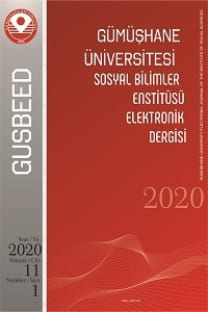Suç-Gelir Dağılımı İlişkisinde Mekansallığın Etkisi: Türkiye’de Düzey 2 Bölgeleri İçin Bir Analiz
The Effect of Spatiality on Crime-Income Distribution Relationship: An Analysis of NUTS 2 Level Regions in Turkey
Income inequality, , Crime, NUTS 2 regions Gini, Spatial Models,
___
Aaltonen M., Kivivuori J., Martikainen P. (2011). Social determinants of crime in a welfare state: do they still matter?, Acta Sociologia, 54(2), 161-181.Allen R. (1996). Socioeconomic conditions and property crime: a comprehensive review and test of the proffesional literature. American Journal of Economics and Sociology, 55(3), 293-308.
Anselin L. (1988). Spatial Econometrics: methods and models. Folmer, H., Regional Economic Policy. 1986. ISBN 90-247-3308-1.
Anselin L. (1988b). Lagrange multiplier test diagnostics for spatial dependence and spatial heterogeneity, Geographical Analysis, 20,1-17
Anselin L., ve Rey S. (1991). Properties of tests for spatial dependence in linear regression models, Geographical Analysis, 23(2), 112-131.
Anselin L., ve Hudak S. (1992). Spatial Econometrics in practice: A review of software options, Regional Science and Urban Economics, 22, 509-536
Anselin L., & Baltagi B.H. (Eds). (2001). Spatial Econometrics A companion to theoretical econometrics. Blackwell Publishing, 311-330.
Anselin L. (2006). Spatial Econometrics, (Der. Mills,Terence C., Kerry Patterson), Palgrave Handbook of Econometrics Vol. 1 Econometric Theory, New York: Palgrave Macmillan. 901-969.
Baharom A., ve Habibullah M.S. (2009). Income, unemployment and crime, panel data analysis on selected european countries, 9th Global Conference on Business&Economics
Becker G.S. (1968). Crime and punishment, an economic approach, The Journal of Political Economy, 76(2), 169-217.
Blau J., ve Blau P. (1982). The cost of inequality, metropolitan structure and violent crime, American Sociological Review, 47, 114-129.
Bourguignon F., Nunez J., Sanchez F. (2003). What part of the income distribution matters for explaining property crime? The case of colombia. Documento, CEDE 2003-07, ISSN 1657-7191.
Burridge, P. (1980). On the Cliff-Ord test for spatial correlation, Journal of the Royal Statistical Society Series B 42(1), 107-108.
Brush J. (2007). Does income inequality lead to more crime? a comparison of cross-sectional and time series analysis of united states countries, Economics Letters, 96, 264-268.
Cheong S. ve Wu Y. (2013). Inequality and crime rates in china, University of Western Australia, Economic Discussion/Working Papers, 13.11.
Choe J. (2008). Income inequality and crime in the united states, Economics Letters, 101, 31–33.
Cliff A., ve Ord J. (1972). Testing for spatial autocorrelation among regression residuals. Geographical Analysis, 4, 267-84.
Cliff A., ve Ord J. (1973). Spatial Autocorrelation. London, Pion.
Danziger S., ve Wheeler D. (1975). The economics of crime: punishment or income redistribution. Review of Social Economy, 33(2), 113-131.
Dursun, H. (1997). Suçun ekonomik modelleri. DPT, iktisadi sektörler ve koordinasyon genel müdürlüğü, hukuki tedbirler ve kurumsal düzenlemeler dairesi başkanlığı.
Ehrlich I. (1973). Participation in illegitimate activities: a theoretical and emprical investigation, Journal of Political Economy, 81(3), 521-565.
Fajnzylber P., Lederman D., Loayza N. (2002a). Inequality and violent crime, Journal of Law and Economics, 45(1), 1-40.
Fajnzylber P., Lederman D., Loayza N. (2002b). What causes violent crime, European Economic Review, 46(7), 1323-1357.
Fleisher B.M. (1966). The effect of income on delinquency, The American Economic Review, 56, (1/2), 118-137.
Freeman R.B. (1982). Crime and the labor market, Working Paper, 1031, National Bureu of Economic Research.
İmrohoroğlu A., Merlo A., Rupert P. (2004). What accounts for the decline in crime, International Economic Review, 45(3), 707-729.
İzaadi N., ve Piraee K. (2012). Income inequality and property crime: evidence from Iran, World Applied Sciences Journal, 19 (2), 281-286.
Kelly M. (2000). Inequality and crime, Review of Economics and Statistics, 82(4), 530–539.
Keshavarz G.H., ve Markazi H.M. (2011). The socioeconomic and demographic determinants of crime in Iran (a regional panel study), European Journal of Law and Economics, 32(1), 99–114.
LeSage J. (1998). Saptial Econometrics, Deparment of Economics, University of Toledo December [Available online at: https://www.spatial-econometrics.com/html/wbook.pdf], Retrieved on November 15, 2019.
LeSage J., ve Pace R.K. (2009). Introduction to Spatial Econometrics , Florida, Chapman and Hall.
Luiz J.M. (2001). Temporal association, the dynamics of crime and other economic determinants: a time series econometric model of South Africa, Social Indicators Research, 53, 33-61.
Merton R.K. (1938). Social structure and anomie, American Sociological Review, 54, 597 - 611.
Moran P. (1950a). Notes on continuous stochastic phenomena, Biometrika 37, 17-23.
Moran P. (1950b). A test for the serial independence of residuals, Biometrika 37, 178-181.
Neumayer E. (2005). Inequality and violent crime: evidence from data on robbery and violent theft, Journal of Peace Research, 42(1), 101-112.
Nilsson A. (2004). Income inequality and crime: the case of Sweden, ınstitute for labour market policy evaluation, Working Paper, 2004(6).
Oliver A. (2002). The economics of crime: an analysis of crime rates in America, The Park Place Economist, 10, 30-35.
Shaw C.R., ve Mckay H.D. (1942). Juvenile delinquency and urban areas: a study of rates of delinquencies in relation to differential characteristics of local communities in American cities, Chicago, University of Chicago Press.
Thorbecke E., ve Charumilind C. (2002). Economic inequality and its socioeconomic impact, World Development, 30(9), 1477-1495.
Warren E.H. (1978). The economic approach to crime, Canadian Journal of Criminology, 20(4).
Yıldız R., Öcal O., Yıldırım E. (2011). Suçun sosyoekonomik belirleyicileri: Kayseri üzerine bir uygulama, Erciyes Üniversitesi İİBF Dergisi, 36, 15-31.
- ISSN: 1309-7423
- Yayın Aralığı: Yılda 3 Sayı
- Yayıncı: Gümüşhane Üniversitesi
Psikolojik Güçlendirme ile Örgütsel Vatandaşlık Davranışı Arasındaki İlişki
Suç-Gelir Dağılımı İlişkisinde Mekansallığın Etkisi: Türkiye’de Düzey 2 Bölgeleri İçin Bir Analiz
Necmiye Tülin İRGE, Yüksel YALÇIN, İ̇̇brahi̇m YILDIRIM
Öğretmen Mesleki Yeterlilik Değerlendirme Kriterlerinin Analitik Hiyerarşi Prosesi (AHP) İle Analizi
Girişimcilik Eğitimi Alan Üniversite Mezunlarının Girişimcilik Eğilimi Üzerine Bir Araştırma
Reel Döviz Kuru ile Turizm Sektörü Arasındaki Nedenselliğin Değerlendirilmesi: Türkiye Örneği
Kürtün (Gümüşhane) İlçesinde Somut Olmayan Kültürel Miras Unsuru Olarak Ahşap El Sanatları
Ayşen Gönül EKŞİOĞLU, Halil İ̇brahim ZEYBEK
TKDK Desteklerinin Bölgesel Kalkınmaya ve Firma Büyüme Performansına Etkisi: Isparta Örneği
